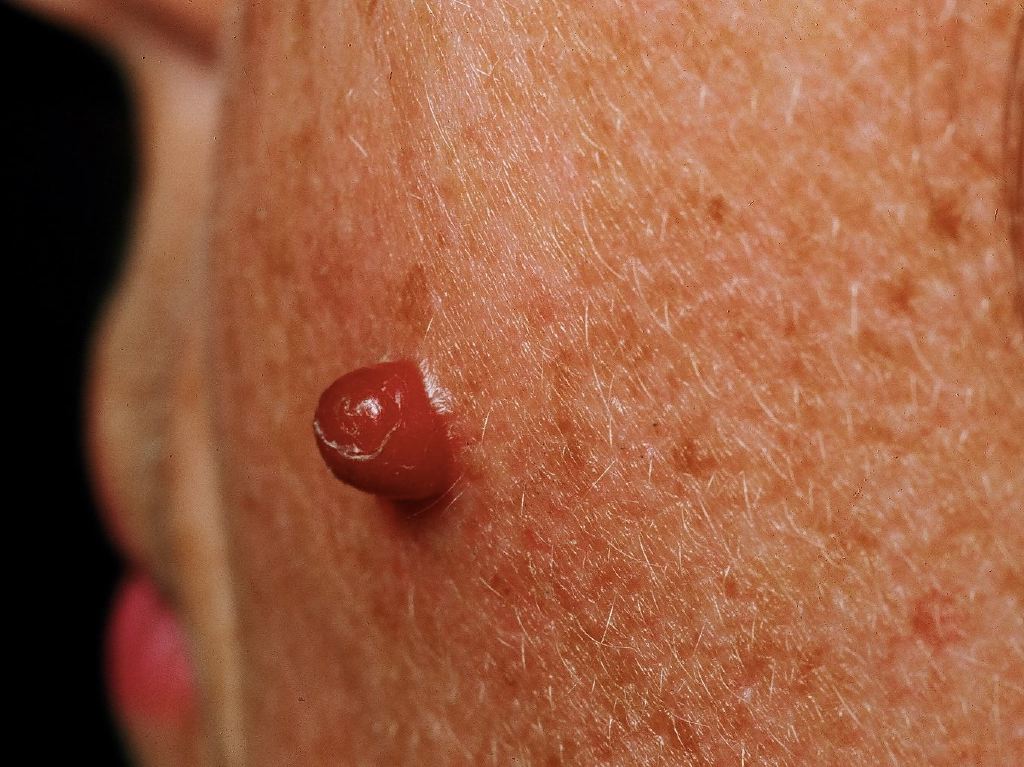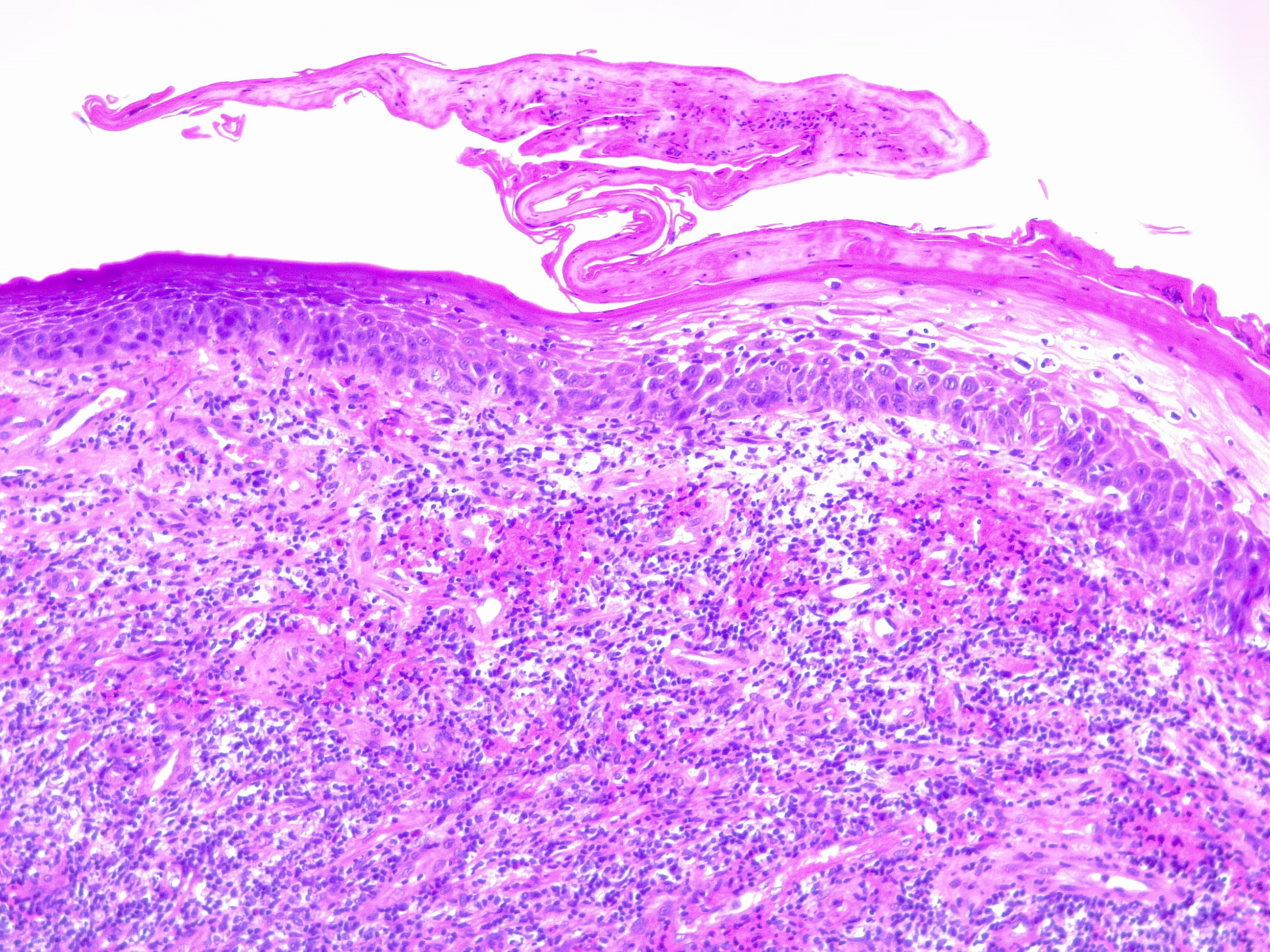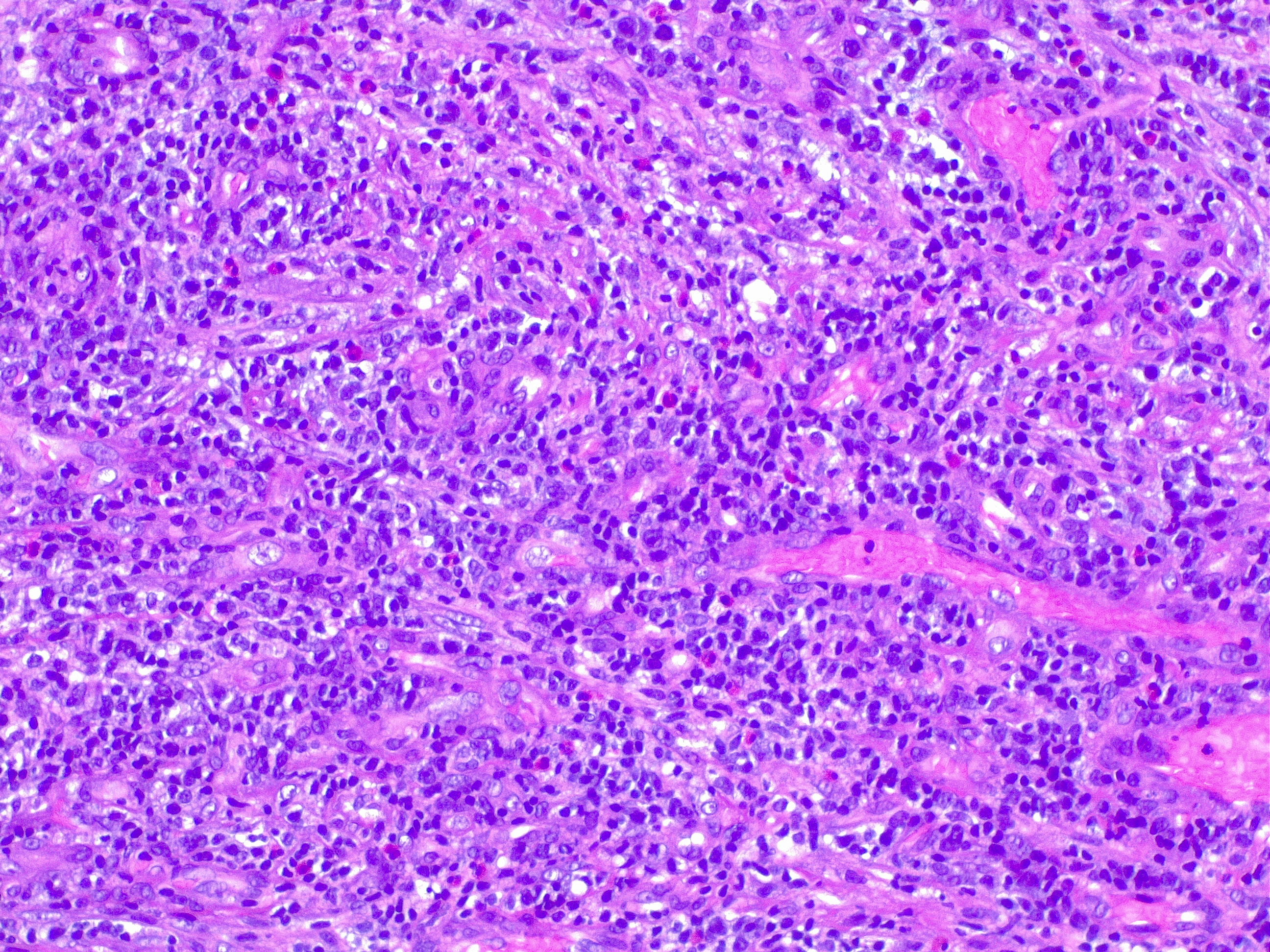[1]
Wollina U, Langner D, França K, Gianfaldoni S, Lotti T, Tchernev G. Pyogenic Granuloma - A Common Benign Vascular Tumor with Variable Clinical Presentation: New Findings and Treatment Options. Open access Macedonian journal of medical sciences. 2017 Jul 25:5(4):423-426. doi: 10.3889/oamjms.2017.111. Epub 2017 Jul 13
[PubMed PMID: 28785323]
[2]
Mills SE, Cooper PH, Fechner RE. Lobular capillary hemangioma: the underlying lesion of pyogenic granuloma. A study of 73 cases from the oral and nasal mucous membranes. The American journal of surgical pathology. 1980 Oct:4(5):470-9
[PubMed PMID: 7435775]
Level 3 (low-level) evidence
[3]
Andrikopoulou M, Chatzistamou I, Gkilas H, Vilaras G, Sklavounou A. Assessment of angiogenic markers and female sex hormone receptors in pregnancy tumor of the gingiva. Journal of oral and maxillofacial surgery : official journal of the American Association of Oral and Maxillofacial Surgeons. 2013 Aug:71(8):1376-81. doi: 10.1016/j.joms.2013.03.009. Epub 2013 Apr 24
[PubMed PMID: 23623199]
[4]
Usui S,Kogame T,Shibuya M,Okamoto N,Toichi E, Case of multiple disseminated cutaneous lobular capillary hemangioma that developed while taking oral contraceptive pills. The Journal of dermatology. 2019 Jun;
[PubMed PMID: 30628110]
Level 3 (low-level) evidence
[5]
al-Zayer M, da Fonseca M, Ship JA. Pyogenic granuloma in a renal transplant patient: case report. Special care in dentistry : official publication of the American Association of Hospital Dentists, the Academy of Dentistry for the Handicapped, and the American Society for Geriatric Dentistry. 2001 Sep-Oct:21(5):187-90
[PubMed PMID: 11803643]
Level 3 (low-level) evidence
[6]
Arbiser JL, Weiss SW, Arbiser ZK, Bravo F, Govindajaran B, Caceres-Rios H, Cotsonis G, Recavarren S, Swerlick RA, Cohen C. Differential expression of active mitogen-activated protein kinase in cutaneous endothelial neoplasms: implications for biologic behavior and response to therapy. Journal of the American Academy of Dermatology. 2001 Feb:44(2):193-7
[PubMed PMID: 11174372]
[7]
Patrice SJ, Wiss K, Mulliken JB. Pyogenic granuloma (lobular capillary hemangioma): a clinicopathologic study of 178 cases. Pediatric dermatology. 1991 Dec:8(4):267-76
[PubMed PMID: 1792196]
Level 3 (low-level) evidence
[8]
Jafarzadeh H, Sanatkhani M, Mohtasham N. Oral pyogenic granuloma: a review. Journal of oral science. 2006 Dec:48(4):167-75
[PubMed PMID: 17220613]
[9]
Harris MN, Desai R, Chuang TY, Hood AF, Mirowski GW. Lobular capillary hemangiomas: An epidemiologic report, with emphasis on cutaneous lesions. Journal of the American Academy of Dermatology. 2000 Jun:42(6):1012-6
[PubMed PMID: 10827405]
[10]
Hugoson A. Gingival inflammation and female sex hormones. A clinical investigation of pregnant women and experimental studies in dogs. Journal of periodontal research. Supplement. 1970:5():1-18
[PubMed PMID: 4249979]
[11]
Alessandrini A, Bruni F, Starace M, Piraccini BM. Periungual Pyogenic Granuloma: The Importance of the Medical History. Skin appendage disorders. 2016 May:1(4):175-8. doi: 10.1159/000444302. Epub 2016 Feb 24
[PubMed PMID: 27386461]
[12]
Zaiac MN, Walker A. Nail abnormalities associated with systemic pathologies. Clinics in dermatology. 2013 Sep-Oct:31(5):627-49. doi: 10.1016/j.clindermatol.2013.06.018. Epub
[PubMed PMID: 24079592]
[13]
Bouscarat F, Bouchard C, Bouhour D. Paronychia and pyogenic granuloma of the great toes in patients treated with indinavir. The New England journal of medicine. 1998 Jun 11:338(24):1776-7
[PubMed PMID: 9625645]
[14]
Piguet V, Borradori L. Pyogenic granuloma-like lesions during capecitabine therapy. The British journal of dermatology. 2002 Dec:147(6):1270-2
[PubMed PMID: 12452889]
[15]
Curr N, Saunders H, Murugasu A, Cooray P, Schwarz M, Gin D. Multiple periungual pyogenic granulomas following systemic 5-fluorouracil. The Australasian journal of dermatology. 2006 May:47(2):130-3
[PubMed PMID: 16637811]
[16]
Devillers C, Vanhooteghem O, Henrijean A, Ramaut M, de la Brassinne M. Subungueal pyogenic granuloma secondary to docetaxel therapy. Clinical and experimental dermatology. 2009 Mar:34(2):251-2. doi: 10.1111/j.1365-2230.2008.02799.x. Epub 2008 Dec 22
[PubMed PMID: 19120399]
[17]
Paul LJ, Cohen PR. Paclitaxel-associated subungual pyogenic granuloma: report in a patient with breast cancer receiving paclitaxel and review of drug-induced pyogenic granulomas adjacent to and beneath the nail. Journal of drugs in dermatology : JDD. 2012 Feb:11(2):262-8
[PubMed PMID: 22270214]
[18]
High WA. Gefitinib: a cause of pyogenic granulomalike lesions of the nail. Archives of dermatology. 2006 Jul:142(7):939
[PubMed PMID: 16847224]
[19]
Segaert S, Van Cutsem E. Clinical signs, pathophysiology and management of skin toxicity during therapy with epidermal growth factor receptor inhibitors. Annals of oncology : official journal of the European Society for Medical Oncology. 2005 Sep:16(9):1425-33
[PubMed PMID: 16012181]
[20]
Dika E, Barisani A, Vaccari S, Fanti PA, Ismaili A, Patrizi A. Periungual pyogenic granuloma following imatinib therapy in a patient with chronic myelogenous leukemia. Journal of drugs in dermatology : JDD. 2013 May:12(5):512-3
[PubMed PMID: 23652942]
[21]
Henning B, Stieger P, Kamarachev J, Dummer R, Goldinger SM. Pyogenic granuloma in patients treated with selective BRAF inhibitors: another manifestation of paradoxical pathway activation. Melanoma research. 2016 Jun:26(3):304-7. doi: 10.1097/CMR.0000000000000248. Epub
[PubMed PMID: 27116335]
[22]
Sammut SJ, Tomson N, Corrie P. Pyogenic granuloma as a cutaneous adverse effect of vemurafenib. The New England journal of medicine. 2014 Sep 25:371(13):1265-7. doi: 10.1056/NEJMc1407683. Epub
[PubMed PMID: 25251629]
[23]
Patruno C, Balato N, Cirillo T, Napolitano M, Ayala F. Periungual and subungual pyogenic granuloma following anti-TNF-α therapy: is it the first case? Dermatologic therapy. 2013 Nov-Dec:26(6):493-5. doi: 10.1111/dth.12022. Epub 2013 Apr 1
[PubMed PMID: 24552415]
Level 3 (low-level) evidence
[24]
Sibaud V, Dalenc F, Mourey L, Chevreau C. Paronychia and pyogenic granuloma induced by new anticancer mTOR inhibitors. Acta dermato-venereologica. 2011 Sep:91(5):584-5. doi: 10.2340/00015555-1097. Epub
[PubMed PMID: 21667012]
[25]
Exner JH, Dahod S, Pochi PE. Pyogenic granuloma-like acne lesions during isotretinoin therapy. Archives of dermatology. 1983 Oct:119(10):808-11
[PubMed PMID: 6225396]
[26]
Benedetto C, Crasto D, Ettefagh L, Nami N. Development of Periungual Pyogenic Granuloma with Associated Paronychia Following Isotretinoin Therapy: A Case Report and a Review of the Literature. The Journal of clinical and aesthetic dermatology. 2019 Apr:12(4):32-36
[PubMed PMID: 31119008]
Level 3 (low-level) evidence
[27]
Lenczowski JM, Cassarino DS, Jain A, Turner ML. Disseminated vascular papules in an immunodeficient patient being treated with granulocyte colony-stimulating factor. Journal of the American Academy of Dermatology. 2003 Jul:49(1):105-8
[PubMed PMID: 12833018]
[28]
Palmero ML, Pope E. Eruptive pyogenic granulomas developing after drug hypersensitivity reaction. Journal of the American Academy of Dermatology. 2009 May:60(5):855-7. doi: 10.1016/j.jaad.2008.11.021. Epub 2009 Feb 10
[PubMed PMID: 19211171]
[29]
Cheney-Peters D, Lund TC. Oral Pyogenic Granuloma After Bone Marrow Transplant in the Pediatric/Adolescent Population: Report of 5 Cases. Journal of pediatric hematology/oncology. 2016 Oct:38(7):570-3. doi: 10.1097/MPH.0000000000000593. Epub
[PubMed PMID: 27271813]
Level 3 (low-level) evidence
[30]
Kanda Y, Arai C, Chizuka A, Suguro M, Hamaki T, Yamamoto R, Yamauchi Y, Matsuyama T, Takezako N, Shirai Y, Miwa A, Iwasaki K, Nasu M, Togawa A. Pyogenic granuloma of the tongue early after allogeneic bone marrow transplantation for multiple myeloma. Leukemia & lymphoma. 2000 Apr:37(3-4):445-9
[PubMed PMID: 10752998]
[31]
Bachmeyer C, Devergie A, Mansouri S, Dubertret L, Aractingi S. [Pyogenic granuloma of the tongue in chronic graft versus host disease]. Annales de dermatologie et de venereologie. 1996:123(9):552-4
[PubMed PMID: 9615106]
[32]
Lee L, Miller PA, Maxymiw WG, Messner HA, Rotstein LE. Intraoral pyogenic granuloma after allogeneic bone marrow transplant. Report of three cases. Oral surgery, oral medicine, and oral pathology. 1994 Nov:78(5):607-10
[PubMed PMID: 7838468]
Level 3 (low-level) evidence
[33]
Bacher J, Assaad D, Adam DN. Pyogenic granuloma of the foot with satellitosis: a role for conservative management. Journal of cutaneous medicine and surgery. 2011 Jan-Feb:15(1):58-60
[PubMed PMID: 21291657]
[34]
Beers BB, Rustad OJ, Vance JC. Pyogenic granuloma following laser treatment of a port-wine stain. Cutis. 1988 Apr:41(4):266-8
[PubMed PMID: 3284723]
[35]
Aghaei S. Pyogenic granuloma arising in port-wine stain after cryotherapy. Dermatology online journal. 2003 Dec:9(5):16
[PubMed PMID: 14996389]
[36]
Koo MG, Lee SH, Han SE. Pyogenic Granuloma: A Retrospective Analysis of Cases Treated Over a 10-Year. Archives of craniofacial surgery. 2017 Mar:18(1):16-20. doi: 10.7181/acfs.2017.18.1.16. Epub 2017 Mar 25
[PubMed PMID: 28913297]
Level 2 (mid-level) evidence
[38]
Seyedmajidi M, Shafaee S, Hashemipour G, Bijani A, Ehsani H. Immunohistochemical Evaluation of Angiogenesis Related Markers in Pyogenic Granuloma of Gingiva. Asian Pacific journal of cancer prevention : APJCP. 2015:16(17):7513-6
[PubMed PMID: 26625754]
[39]
Johnson EF, Davis DM, Tollefson MM, Fritchie K, Gibson LE. Vascular Tumors in Infants: Case Report and Review of Clinical, Histopathologic, and Immunohistochemical Characteristics of Infantile Hemangioma, Pyogenic Granuloma, Noninvoluting Congenital Hemangioma, Tufted Angioma, and Kaposiform Hemangioendothelioma. The American Journal of dermatopathology. 2018 Apr:40(4):231-239. doi: 10.1097/DAD.0000000000000983. Epub
[PubMed PMID: 29561329]
Level 3 (low-level) evidence
[40]
Adams DO. The granulomatous inflammatory response. A review. The American journal of pathology. 1976 Jul:84(1):164-92
[PubMed PMID: 937513]
[41]
Lawoyin JO, Arotiba JT, Dosumu OO. Oral pyogenic granuloma: a review of 38 cases from Ibadan, Nigeria. The British journal of oral & maxillofacial surgery. 1997 Jun:35(3):185-9
[PubMed PMID: 9212296]
Level 3 (low-level) evidence
[42]
Zain RB, Khoo SP, Yeo JF. Oral pyogenic granuloma (excluding pregnancy tumour)--a clinical analysis of 304 cases. Singapore dental journal. 1995 Jul:20(1):8-10
[PubMed PMID: 9582682]
Level 3 (low-level) evidence
[43]
Putra J, Rymeski B, Merrow AC, Dasgupta R, Gupta A. Four cases of pediatric deep-seated/subcutaneous pyogenic granuloma: Review of literature and differential diagnosis. Journal of cutaneous pathology. 2017 Jun:44(6):516-522. doi: 10.1111/cup.12923. Epub 2017 Mar 23
[PubMed PMID: 28233342]
Level 3 (low-level) evidence
[44]
Johnson NA,Haeney J,Yii NW, Intravenous pyogenic granuloma of the finger. The Journal of hand surgery, European volume. 2011 Mar;
[PubMed PMID: 21282218]
[45]
Joethy J, Al Jajeh I, Tay SC. Intravenous pyogenic granuloma of the hand - a case report. Hand surgery : an international journal devoted to hand and upper limb surgery and related research : journal of the Asia-Pacific Federation of Societies for Surgery of the Hand. 2011:16(1):87-9
[PubMed PMID: 21348038]
Level 3 (low-level) evidence
[46]
Meeks MW, Kamal UM, Hammami MB, Taylor JR, Omran ML, Chen Y, Lai JP. Gastrointestinal Pyogenic Granuloma (Lobular Capillary Hemangioma): An Underrecognized Entity Causing Iron Deficiency Anemia. Case reports in gastrointestinal medicine. 2016:2016():4398401. doi: 10.1155/2016/4398401. Epub 2016 Jun 15
[PubMed PMID: 27403353]
Level 3 (low-level) evidence
[47]
Blickenstaff RD, Roenigk RK, Peters MS, Goellner JR. Recurrent pyogenic granuloma with satellitosis. Journal of the American Academy of Dermatology. 1989 Dec:21(6):1241-4
[PubMed PMID: 2584462]
[48]
Benmously-Mlika R, Hammami H, Mokhtar I. Violaceous papules of the back: a quiz. Diagnosis: recurrent pyogenic granuloma or Warner and Wilson-Jones syndrome (1, 2). Acta dermato-venereologica. 2011 Jun:91(4):491-4. doi: 10.2340/00015555-1008. Epub
[PubMed PMID: 21103841]
[49]
Dillman AM, Miller RC, Hansen RC. Multiple pyogenic granulomata in childhood. Pediatric dermatology. 1991 Mar:8(1):28-31
[PubMed PMID: 1862021]
[50]
Wilson BB, Greer KE, Cooper PH. Eruptive disseminated lobular capillary hemangioma (pyogenic granuloma). Journal of the American Academy of Dermatology. 1989 Aug:21(2 Pt 2):391-4
[PubMed PMID: 2754072]
[51]
Shah M, Kingston TP, Cotterill JA. Eruptive pyogenic granulomas: a successfully treated patient and review of the literature. The British journal of dermatology. 1995 Nov:133(5):795-6
[PubMed PMID: 8555038]
[52]
Ceyhan AM, Basak PY, Akkaya VB, Yildirim M, Kapucuoglu N. A case of multiple, eruptive pyogenic granuloma developed on a region of the burned skin: can erythromycin be a treatment option? Journal of burn care & research : official publication of the American Burn Association. 2007 Sep-Oct:28(5):754-7
[PubMed PMID: 17667838]
Level 3 (low-level) evidence
[53]
Zaballos P, Carulla M, Ozdemir F, Zalaudek I, Bañuls J, Llambrich A, Puig S, Argenziano G, Malvehy J. Dermoscopy of pyogenic granuloma: a morphological study. The British journal of dermatology. 2010 Dec:163(6):1229-37. doi: 10.1111/j.1365-2133.2010.10040.x. Epub
[PubMed PMID: 20846306]
[54]
Lee J, Sinno H, Tahiri Y, Gilardino MS. Treatment options for cutaneous pyogenic granulomas: a review. Journal of plastic, reconstructive & aesthetic surgery : JPRAS. 2011 Sep:64(9):1216-20. doi: 10.1016/j.bjps.2010.12.021. Epub 2011 Feb 11
[PubMed PMID: 21316320]
[55]
Ghodsi SZ, Raziei M, Taheri A, Karami M, Mansoori P, Farnaghi F. Comparison of cryotherapy and curettage for the treatment of pyogenic granuloma: a randomized trial. The British journal of dermatology. 2006 Apr:154(4):671-5
[PubMed PMID: 16536810]
Level 1 (high-level) evidence
[56]
Mirshams M, Daneshpazhooh M, Mirshekari A, Taheri A, Mansoori P, Hekmat S. Cryotherapy in the treatment of pyogenic granuloma. Journal of the European Academy of Dermatology and Venereology : JEADV. 2006 Aug:20(7):788-90
[PubMed PMID: 16898898]
[57]
Quitkin HM, Rosenwasser MP, Strauch RJ. The efficacy of silver nitrate cauterization for pyogenic granuloma of the hand. The Journal of hand surgery. 2003 May:28(3):435-8
[PubMed PMID: 12772100]
[58]
Sud AR, Tan ST. Pyogenic granuloma-treatment by shave-excision and/or pulsed-dye laser. Journal of plastic, reconstructive & aesthetic surgery : JPRAS. 2010 Aug:63(8):1364-8. doi: 10.1016/j.bjps.2009.06.031. Epub 2009 Jul 21
[PubMed PMID: 19625228]
[59]
Raulin C, Greve B, Hammes S. The combined continuous-wave/pulsed carbon dioxide laser for treatment of pyogenic granuloma. Archives of dermatology. 2002 Jan:138(1):33-7
[PubMed PMID: 11790165]
[60]
Hammes S, Kaiser K, Pohl L, Metelmann HR, Enk A, Raulin C. Pyogenic granuloma: treatment with the 1,064-nm long-pulsed neodymium-doped yttrium aluminum garnet laser in 20 patients. Dermatologic surgery : official publication for American Society for Dermatologic Surgery [et al.]. 2012 Jun:38(6):918-23. doi: 10.1111/j.1524-4725.2012.02344.x. Epub 2012 Jan 24
[PubMed PMID: 22272571]
[61]
Tritton SM, Smith S, Wong LC, Zagarella S, Fischer G. Pyogenic granuloma in ten children treated with topical imiquimod. Pediatric dermatology. 2009 May-Jun:26(3):269-72. doi: 10.1111/j.1525-1470.2008.00864.x. Epub
[PubMed PMID: 19706086]
[62]
Maloney DM, Schmidt JD, Duvic M. Alitretinoin gel to treat pyogenic granuloma. Journal of the American Academy of Dermatology. 2002 Dec:47(6):969-70
[PubMed PMID: 12451394]
[63]
Knöpfel N, Escudero-Góngora MDM, Bauzà A, Martín-Santiago A. Timolol for the treatment of pyogenic granuloma (PG) in children. Journal of the American Academy of Dermatology. 2016 Sep:75(3):e105-e106. doi: 10.1016/j.jaad.2016.03.036. Epub
[PubMed PMID: 27543231]
[64]
Neri I, Baraldi C, Balestri R, Piraccini BM, Patrizi A. Topical 1% propranolol ointment with occlusion in treatment of pyogenic granulomas: An open-label study in 22 children. Pediatric dermatology. 2018 Jan:35(1):117-120. doi: 10.1111/pde.13372. Epub 2017 Dec 20
[PubMed PMID: 29266656]
[65]
Losa Iglesias ME, Becerro de Bengoa Vallejo R. Topical phenol as a conservative treatment for periungual pyogenic granuloma. Dermatologic surgery : official publication for American Society for Dermatologic Surgery [et al.]. 2010 May:36(5):675-8. doi: 10.1111/j.1524-4725.2010.01528.x. Epub 2010 Apr 2
[PubMed PMID: 20384744]
[66]
Parisi E, Glick PH, Glick M. Recurrent intraoral pyogenic granuloma with satellitosis treated with corticosteroids. Oral diseases. 2006 Jan:12(1):70-2
[PubMed PMID: 16390473]
[67]
Hong SK, Lee HJ, Seo JK, Lee D, Hwang SW, Sung HS. Reactive vascular lesions treated using ethanolamine oleate sclerotherapy. Dermatologic surgery : official publication for American Society for Dermatologic Surgery [et al.]. 2010 Jul:36(7):1148-52. doi: 10.1111/j.1524-4725.2010.01599.x. Epub 2010 Jun 1
[PubMed PMID: 20533938]
[68]
Moon SE, Hwang EJ, Cho KH. Treatment of pyogenic granuloma by sodium tetradecyl sulfate sclerotherapy. Archives of dermatology. 2005 May:141(5):644-6
[PubMed PMID: 15897398]
[69]
Carvalho RA, Neto V. Letter: Polidocanol sclerotherapy for the treatment of pyogenic granuloma. Dermatologic surgery : official publication for American Society for Dermatologic Surgery [et al.]. 2010 Jun:36 Suppl 2():1068-70. doi: 10.1111/j.1524-4725.2009.01470.x. Epub
[PubMed PMID: 20590716]
Level 3 (low-level) evidence
[70]
Daya M. Complete resolution of a recurrent giant pyogenic granuloma on the palm of the hand following single dose of intralesional bleomycin injection. Journal of plastic, reconstructive & aesthetic surgery : JPRAS. 2010 Mar:63(3):e331-3. doi: 10.1016/j.bjps.2009.07.002. Epub 2009 Jul 26
[PubMed PMID: 19632910]
[71]
Lacouture ME, Anadkat MJ, Bensadoun RJ, Bryce J, Chan A, Epstein JB, Eaby-Sandy B, Murphy BA, MASCC Skin Toxicity Study Group. Clinical practice guidelines for the prevention and treatment of EGFR inhibitor-associated dermatologic toxicities. Supportive care in cancer : official journal of the Multinational Association of Supportive Care in Cancer. 2011 Aug:19(8):1079-95. doi: 10.1007/s00520-011-1197-6. Epub 2011 Jun 1
[PubMed PMID: 21630130]
Level 1 (high-level) evidence
[72]
Al-Thunayan A, Al-Rehaili M, Al-Meshal O, Al-Qattan MM. Bacillary angiomatosis presenting as a pyogenic granuloma of the hand in an otherwise apparently healthy patient. Annals of plastic surgery. 2013 Jun:70(6):652-3. doi: 10.1097/SAP.0b013e31823b6866. Epub
[PubMed PMID: 23038144]
[73]
Nthumba PM. Giant pyogenic granuloma of the thigh: a case report. Journal of medical case reports. 2008 Mar 31:2():95. doi: 10.1186/1752-1947-2-95. Epub 2008 Mar 31
[PubMed PMID: 18377654]
Level 3 (low-level) evidence
[74]
Kapadia SB, Heffner DK. Pitfalls in the histopathologic diagnosis of pyogenic granuloma. European archives of oto-rhino-laryngology : official journal of the European Federation of Oto-Rhino-Laryngological Societies (EUFOS) : affiliated with the German Society for Oto-Rhino-Laryngology - Head and Neck Surgery. 1992:249(4):195-200
[PubMed PMID: 1642875]
[75]
Løes S, Tornes K. Misinterpretation of histopathological results as an important risk factor for unneeded surgery - case report of a "near miss" event in a pregnant woman. Patient safety in surgery. 2008 Jun 5:2():14. doi: 10.1186/1754-9493-2-14. Epub 2008 Jun 5
[PubMed PMID: 18534003]
Level 3 (low-level) evidence




